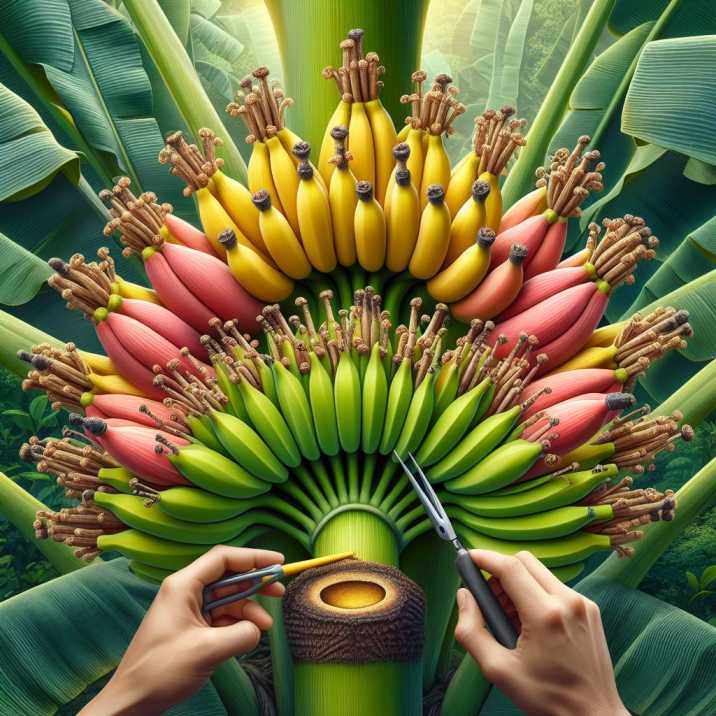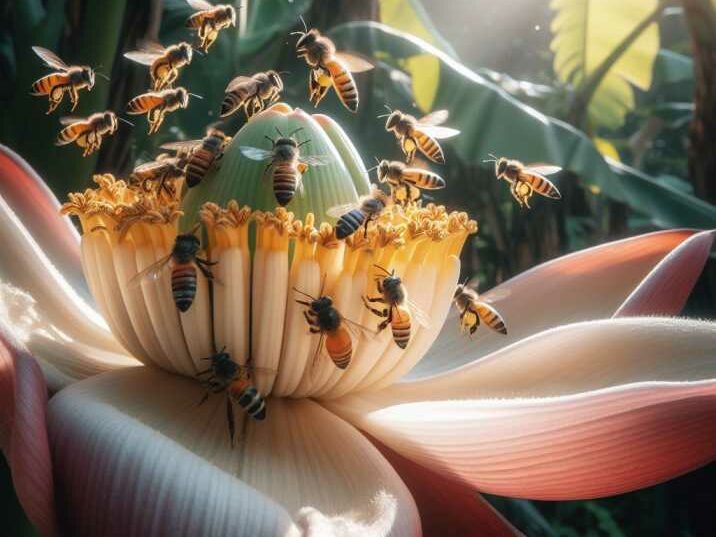Introduction:
Table of Contents
proper pollination for baby banana plants
Bananas are one of the most popular fruits worldwide, loved for their sweetness, versatility, and nutritional value. Behind every bunch of bananas lies a fascinating process of pollination, crucial for the development of healthy fruits. When it comes to baby banana plants, ensuring proper pollination is essential for their growth and eventual fruit production. In this comprehensive guide, we’ll delve into the intricacies of proper pollination for baby banana plants, offering valuable insights and practical tips for maximizing their yield and quality.

Understanding Banana Plant Reproduction:
Before diving into pollination techniques, it’s crucial to understand the reproductive biology of banana plants. Unlike many fruit-bearing plants, bananas are monocots and do not produce seeds through pollination. Instead, they rely on a process called parthenocarpy, where fruits develop without fertilization. However, proper pollination for baby banana plants still plays a vital role in fruit formation and quality.
Selecting Healthy Parent Plants:
The first step in ensuring successful pollination is selecting healthy parent plants. Opt for banana plants that are disease-free, robust, and actively growing. Healthy parent plants contribute to strong offspring, capable of withstanding environmental stressors and producing high-quality fruits.
Providing Optimal Growing Conditions:
Creating optimal growing conditions is essential for promoting flower development and subsequent pollination. Baby banana plants thrive in warm, humid climates with well-draining soil and ample sunlight. Ensure adequate irrigation and fertilization to support healthy growth and flower production.
Encouraging Flower Formation:
Banana plants produce flowers within a specialized structure called a inflorescence or “banana heart.” To encourage flower formation in baby banana plants, maintain optimal growing conditions and provide sufficient nutrients, especially potassium. Pruning excess leaves can also redirect energy towards flower production.
Timing Is Key:
Timing plays a crucial role in banana plant pollination. Flowers typically emerge within 6 to 8 months after planting, signaling the onset of the pollination period. Monitor the development of flower buds closely to determine the optimal time for pollination.
Hand Pollination Techniques:
Given the unique reproductive biology of banana plants, hand pollination is often necessary to ensure fruit development. Use a soft brush or cotton swab to transfer pollen from the male flower (stamen) to the female flower (pistil) gently. Repeat the process several times to enhance pollination success.
Maximizing Pollinator Presence:
While bananas are predominantly self-pollinating, increasing pollinator presence can improve fruit set and quality. Encourage the presence of pollinators such as bees, butterflies, and birds by planting pollinator-friendly flowers nearby. Avoid using pesticides that may harm beneficial pollinators.

Proper Fruit Thinning:
After successful pollination, proper fruit thinning is essential to optimize fruit size and quality. Remove excess fruits from the inflorescence, allowing sufficient space for remaining fruits to develop fully. Thinning also reduces the risk of pest and disease infestations.
Managing Environmental Factors:
Environmental factors such as temperature, humidity, and wind can impact pollination success in banana plants. Maintain stable environmental conditions within the optimal range to minimize stress on the plants and facilitate successful pollination.
Monitoring and Maintenance:
Continuous monitoring and maintenance are crucial throughout the pollination process and beyond. Inspect banana plants regularly for signs of pests, diseases, or nutrient deficiencies that may affect pollination and fruit development. Address any issues promptly to ensure optimal plant health and productivity.
Conclusion:
proper pollination for baby banana plants is essential for the successful growth and fruit production of baby banana plants. By understanding the unique reproductive biology of banana plants and implementing appropriate pollination techniques, growers can maximize yield and quality. From selecting healthy parent plants to monitoring environmental factors, each step plays a vital role in ensuring optimal pollination and ultimately, delicious bananas for harvest.
FAQs:
- What is the significance of pollination in banana plants?
- Pollination is crucial for fruit development and quality in banana plants, although bananas are primarily parthenocarpic.
- Can baby banana plants self-pollinate?
- Yes, baby banana plants have both male and female flowers and can self-pollinate, but hand pollination may enhance fruit set.
- How often should I hand pollinate baby banana plants?
- Hand pollination can be done every 2-3 days during the flowering period to ensure thorough pollination.
- What environmental conditions are ideal for banana plant pollination?
- Banana plants prefer warm, humid climates with stable temperatures and minimal wind during the flowering period.
- Can I use artificial pollination methods for baby banana plants?
- Yes, artificial pollination methods such as hand pollination are commonly used to ensure optimal fruit development.
